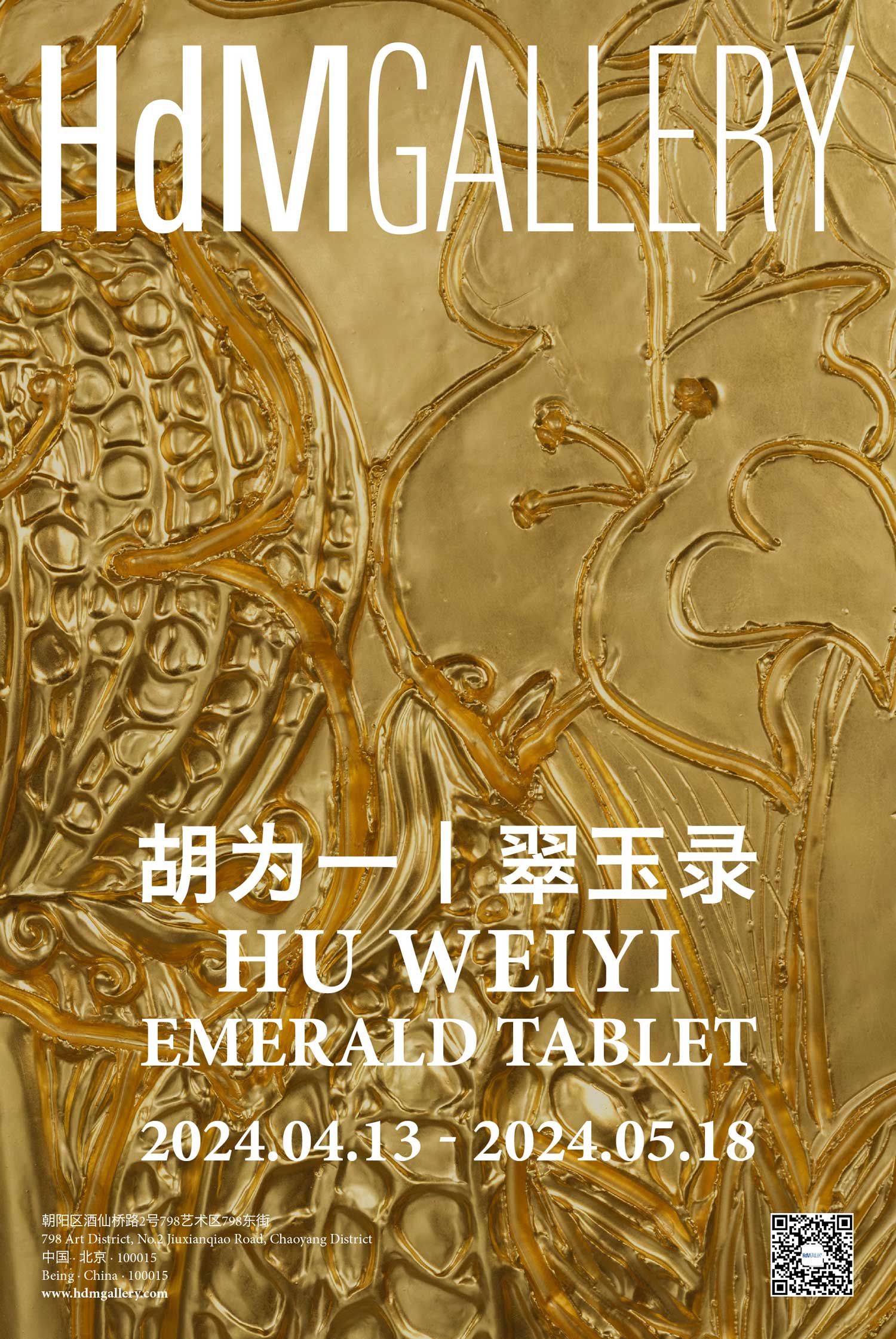展期 Period:
2024.4.13—2024.5.18
艺术家 Artist:
地点 Venue:
新闻稿 Press Release:
HdM画廊欣然宣布将于4月13日举办艺术家胡为一的个展“翠玉录”,此次展览是继2019年和2021年后艺术家在画廊空间举办的第三次个展。展出全新创作的系列雕塑和摄影装置作品。不同于胡为一以往的创作方式,此次展览的内容涉及多种学科,包含了对炼金术、人工智能、植物学等等领域的跨学科探讨。为人类、自然、科技三者在当下无法调和的矛盾寻求启示。
“翠玉录”(Emerald Tablet),取名于传说中发现于古埃及法老墓穴的一块由赫尔墨斯·特里斯梅吉斯图斯(Hermes Trismegistus)所写的翠绿色石板。石板上记载的内容对西方神秘学及炼金术产生重要影响,被认为包含了宇宙的根本原理和炼金术的秘密。与作为古老中世纪的一种神秘主义哲学思想的炼金术(Alchemy)不同,艺术家感兴趣的是“翠玉录”所蕴藏的当代性。在暗访了数家民间电子垃圾回收作坊后,艺术家发现一项危险而又神秘的地下产业,人们通过化学的方式将废弃的电路板、芯片等电子元件中用于传导的黄金提取出来。跨越千年的炼金术以翠绿色的“Tablet”电路板再次问世,但这次智者的精神启示则变成了以科技企业为主导的资本主义淘金冒险。
技术爆炸后的另一产物AI,却和神秘炼金术以完全相反的光鲜姿态出世。在新作品中艺术家将首次使用AI技术,通过其强大的绘图能力,让几个世纪以来因人类的活动而灭绝了的植物在图像层面“复活”。根据这些图像艺术家一边采用传统泥塑的方法还原,一边邀请儿童不断用身体接触进行破坏,儿童本能的身体行为和智能计算平台相互角力,使标准化图示回归到自然生命的状态。
最终从数吨芯片中炼出来的黄金被制成金箔并覆盖雕塑表面,成为迷人的金色图腾。芯片在技术层面进阶为AI,在社会面则下沉到淘金者的身体劳动,最终艺术家的实践让精神(AI图形)和物质(黄金)两线殊途同归。这就如同翠玉录13条箴言中第二和第三条所述:
下如同上,上如同下;依此成全太一的奇迹。
万物本是太一,借由分化从太一创造出来。
在展厅中央呈现的摄影装置作品“梦中身”也从“反另人类化”(Othering) 的角度探寻了古老炼金术中万物归一的观念。艺术家从数万张从医院收集来的X光片中挑选并拼贴成人形,白骨形态消解了性别、种族、阶级等等差异性,而生长于之上的植物更是象征着某种跨物种的想象。经过植物作为ta者的介入,我们也 “酷儿化”为ta者,不仅从二元性身份带来的压迫模式中剥离更是在“人类身份与非人类身份”的规范性二元论中撕开裂缝,回归到生命体(life-forms)和生命形式(forms of life)。
翠玉录向我们展示的 “一切都是一”(All is One)的古老哲学观念,是观宇宙万物为统一整体的视野,尤其在危机四伏的人类世,当人类作为气候变化的组成部分,是否应该视植物的濒危遭遇为自身处境?当艺术家陷入不断平滑化的数字图像中,该如何用肉身对其做出否定性(Negativität)反馈?重拾炼金术的宇宙观,用一种相互依存的平衡姿态内触自身并外接万物,是这个展览想要给出的意义。
HdM Gallery is pleased to announce the opening of Hu Weiyi’s solo exhibition "Emerald Tablet" on April 13th. This is Hu Weiyi's third solo exhibition in the gallery since his 2019 and 2021 solo shows. It features a series of newly created sculptures and photographic installations. Apart from the artist’s previous practice, "Emerald Tablet" interweaves his studies in various disciplines, including the exploration of alchemy, artificial intelligence, botany, etc. This exhibition seeks a solution to the irreconcilable contradictions between humanity, nature, and technology.
"Emerald Tablet" is named after the Tabula Smaragdina written by Hermes Trismegistus, which was found in the tomb of an ancient Egyptian pharaoh. The contents carved onto the tablet had a significant impact on Western occultism and alchemy. It was believed to contain the fundamental philosophy of the universe and the ultimate secrets of alchemy. Moving on from the occult philosophical ideology of ancient Medieval times, the artist expresses a more substantial interest in the contemporary nature of the tablet itself. After visiting several private electronic waste recycling workshops, Hu discovered a dangerous but mystical underground industry in which people extracted conduction gold from discarded circuit boards, chips, and other wasted electronic components. The millennia-old alchemy has reappeared on the green circuit "Tablets," but this time, the spiritual revelation of Hermes Trismegistus has been transformed into a capitalist gold rush led by tech companies.
After the explosion of technology, AI emerged in a completely different guise from a mysterious alchemy. In his new creation, Hu will, for the first time, utilize the powerful image-producing abilities of AI to resurrect plants that have been extinct for centuries due to human activities. The artist will then restore these images using traditional clay sculpting methods while inviting children to interact and continuously destroy the sculpture through physical contact. The spontaneous actions of children will create a tug-of-war with the intelligent computational platform, allowing standardized representations of AI to revert to a cycle of natural life.
The gold refined from tons of electronic chips is compressed into gold foil, covering the sculptures' surface and transforming them into fascinating golden totems. The chips are advanced into AI technically but simultaneously descend to the physical labor of "gold diggers" on the social level. The artist's ultimate practice allows the spiritual form (AI graphics) and material (gold) to converge through different paths, which echoes the second and third lines from the 13 aphorisms of the Emerald Tablet:
That which is below is like that which is above and that which is above is like that which is below to do ye miracles of one only thing.
And as all things have been and arose from one by ye mediation of one: so all things have their birth from this one thing by adaptation.
The photographic installation "Dream Body" displayed in the center of the gallery explores the ancient alchemical notion of "All is One" from the perspective of "Othering." The artist selects and collages human bones from thousands of X-rays collected from hospitals and dissolves differences such as gender, race, and class in a skeletal form, while the plants growing on top convey a particular representation of interspecies imagination. Throughout the external intervention of plants, we are also "queered" into being the "other." Hu’s practice is not only stripping away the oppressive restrictions brought by binary identities but also abandoning the normative binary of "human identity vs. non-human identity" and simply returning to life-forms and forms of life.
The ancient philosophy of "All in One" shown on the Emerald Tablet conveys a perspective of viewing all elements as a unified whole that is particularly precious in the tumultuous Anthropocene. Especially when humans are responsible for climate change, should we stand in the shoes of endangered species as we all are integral parts of the ecosystem? When the artist immerses himself into the continuously normalized digital images, will he be able to develop a "Negativität" discourse through his physical body? Rediscovering the alchemy cosmology and adopting the balance between the inner self and the external world is what the exhibition seeks to convey.

